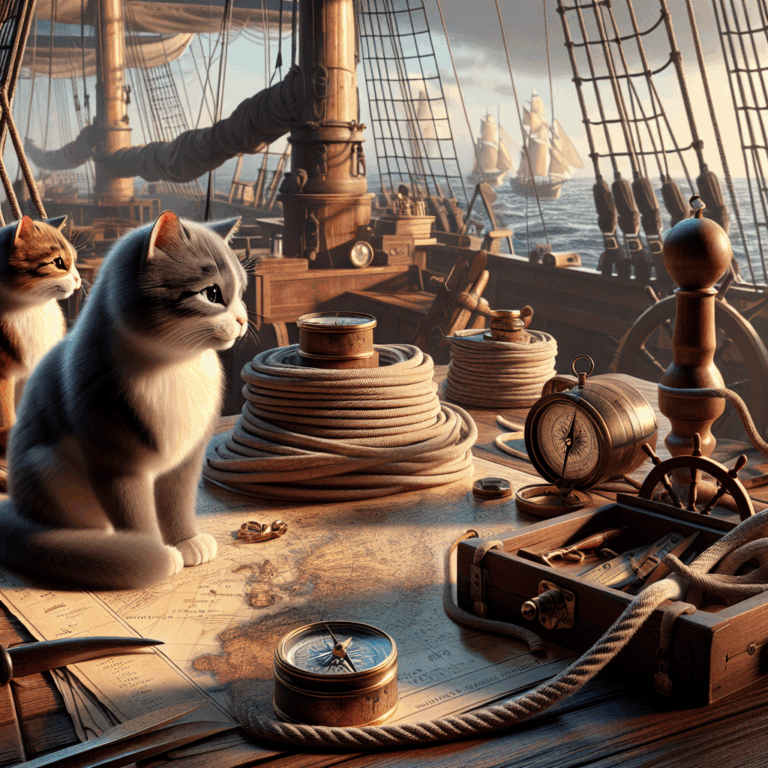The Feline Innovators of Maritime Exploration: Cats and Their Role in Nautical History
- No Comments
Throughout history, cats have been silent yet indispensable companions in the world of maritime exploration. As ships set sail across uncharted waters, these curious and agile creatures accompanied sailors on their treacherous journeys, playing a critical role in the success of many nautical expeditions. Their presence aboard ships not only provided companionship but also contributed significantly to the health and safety of the crew, showcasing an unexpected yet vital partnership between humans and felines.
The origin of cats on ships can be traced back to ancient civilizations, where they were first recognized for their uncanny ability to control the rodent populations that plagued seafaring vessels. Rats and mice posed a serious threat to food supplies, spreading diseases and chewing through ropes and sails. By bringing cats aboard, sailors found a natural and efficient solution to this persistent problem. The cats, with their keen hunting instincts, kept the rodent populations in check, ensuring that provisions remained intact and the ship’s integrity was maintained.
As explorers ventured further into the unknown, cats became a common sight on ships traversing the vast oceans. Their importance was not solely limited to pest control; these maritime felines were also believed to bring good luck and fortune. Sailors, often superstitious by nature, considered cats as omens of fair weather and safe passages. A ship with a cat on board was thought to be protected from storms and other maritime disasters, adding a layer of psychological comfort to the crew’s arduous voyages.
Notable historical figures recognized the value of cats at sea. The great explorer Christopher Columbus is said to have had cats aboard his ships during his famous voyages to the New World. Similarly, Captain James Cook, renowned for his expeditions to the Pacific, also included felines in his crew, acknowledging their role in maintaining the ship’s hygiene and morale. These cats, though they never held official titles, were an integral part of the crew, earning their keep through their diligence and adaptability.
Beyond their practical contributions, cats offered emotional support to sailors who faced long months away from home. The presence of a friendly feline provided comfort and companionship, easing loneliness and stress during lengthy voyages. In cramped quarters, their playful antics and affectionate nature were a source of entertainment and joy, improving the overall well-being of the crew.
In contemporary maritime practices, the legacy of ship cats continues to be honored. While modern technology has largely replaced the need for feline pest control, the tradition of having a ship’s cat remains celebrated in naval culture. Museums and historical exhibitions often feature the stories of famous ship cats, paying homage to their contributions to nautical history.
The tale of cats and their involvement in maritime exploration is a testament to the enduring bond between humans and animals. As silent partners in discovery, these feline adventurers played a vital role in shaping the course of history, leaving an indelible paw print on the annals of nautical exploration. Today, they are remembered not just as stowaways, but as essential crew members who helped navigate the seas and discover new worlds.

Throughout history, cats have been silent yet indispensable companions in the world of maritime exploration. As ships set sail across uncharted waters, these curious and agile creatures accompanied sailors on their treacherous journeys, playing a critical role in the success of many nautical expeditions. Their presence aboard ships not only provided companionship but also contributed significantly to the health and safety of the crew, showcasing an unexpected yet vital partnership between humans and felines.
The origin of cats on ships can be traced back to ancient civilizations, where they were first recognized for their uncanny ability to control the rodent populations that plagued seafaring vessels. Rats and mice posed a serious threat to food supplies, spreading diseases and chewing through ropes and sails. By bringing cats aboard, sailors found a natural and efficient solution to this persistent problem. The cats, with their keen hunting instincts, kept the rodent populations in check, ensuring that provisions remained intact and the ship’s integrity was maintained.
As explorers ventured further into the unknown, cats became a common sight on ships traversing the vast oceans. Their importance was not solely limited to pest control; these maritime felines were also believed to bring good luck and fortune. Sailors, often superstitious by nature, considered cats as omens of fair weather and safe passages. A ship with a cat on board was thought to be protected from storms and other maritime disasters, adding a layer of psychological comfort to the crew’s arduous voyages.
Notable historical figures recognized the value of cats at sea. The great explorer Christopher Columbus is said to have had cats aboard his ships during his famous voyages to the New World. Similarly, Captain James Cook, renowned for his expeditions to the Pacific, also included felines in his crew, acknowledging their role in maintaining the ship’s hygiene and morale. These cats, though they never held official titles, were an integral part of the crew, earning their keep through their diligence and adaptability.
Beyond their practical contributions, cats offered emotional support to sailors who faced long months away from home. The presence of a friendly feline provided comfort and companionship, easing loneliness and stress during lengthy voyages. In cramped quarters, their playful antics and affectionate nature were a source of entertainment and joy, improving the overall well-being of the crew.
In contemporary maritime practices, the legacy of ship cats continues to be honored. While modern technology has largely replaced the need for feline pest control, the tradition of having a ship’s cat remains celebrated in naval culture. Museums and historical exhibitions often feature the stories of famous ship cats, paying homage to their contributions to nautical history.
The tale of cats and their involvement in maritime exploration is a testament to the enduring bond between humans and animals. As silent partners in discovery, these feline adventurers played a vital role in shaping the course of history, leaving an indelible paw print on the annals of nautical exploration. Today, they are remembered not just as stowaways, but as essential crew members who helped navigate the seas and discover new worlds.


